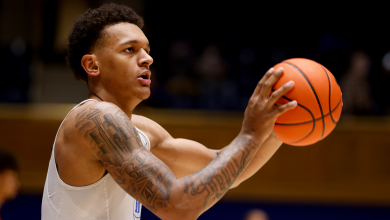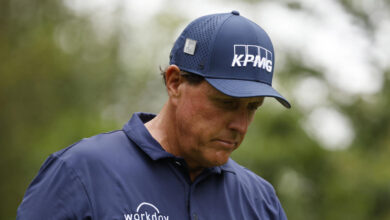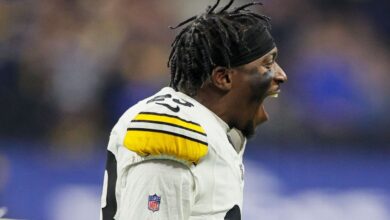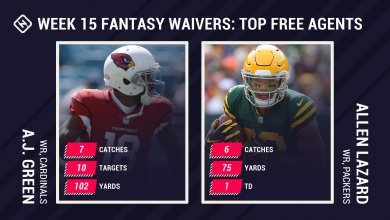College Football Playoff — How Alabama’s Nick Saban mentors and motivates QBs
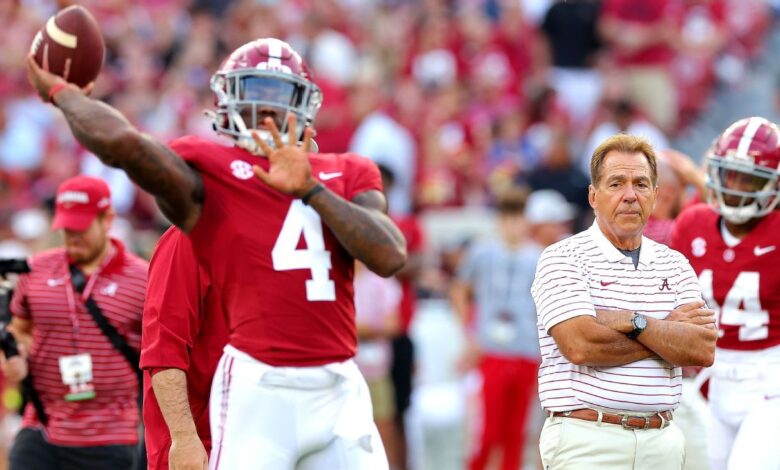
Greg McElroy recalled waiting until after his freshman year in 2007 to ask Alabama coach Nick Saban for a favor. McElroy figured Saban didn’t need the whole backstory about his dad’s lifelong dream to see him wear Joe Namath’s number, so he pulled Saban aside one day and asked him straight up for the change to No. 12.
“You know,” Saban said, “that’s the number I wore.”
McElroy said he shot back, “Yeah, that’s of course why I want to switch to it. Namath, [Kenny] Stabler, those guys have nothing to do with it. It’s really about you.”
Saban obliged, but the accommodation came with expectations. Because Saban not only wore No. 12, he wore it while quarterbacking his high school to a state championship in 1968. It’s a fact that every Alabama quarterback who spoke to ESPN said they were aware of — even Bryce Young, who wasn’t born until three decades later. Young grinned and said Saban will “tell you about the West Virginia days, for sure.”
A former Monongah High teammate, Walter Baranski, said Saban was “the top dog out there.” Jim Pulice, another teammate, added, “He could walk out on the field and see a defense and catch it all.”
Tua Tagovailoa said Saban would boast that “he’s the best athlete.” Saban was well rounded, all-state in basketball and baseball as well. If he wasn’t a few hairs shy of 6-feet, he might have lasted longer as a quarterback at Kent State before making the switch to defensive back. “I couldn’t see as well, especially in the pocket,” Saban recalled of the transition to college. “But if it just came to throwing the ball and doing that stuff, I was OK.”
While he never switched back to offense, instead developing into one of the preeminent defensive minds in football, his background playing quarterback informed his relationship with the position as a head coach. We spoke to seven current or former starters at Alabama to learn more about their day-to-day interactions. Together, they told the story of a coach who invests his time in order to build trust and ultimately benefit the team. There are regular one-on-one meetings that can range from discussion of X’s and O’s and personnel to how to handle interpersonal relationships and the grind of a long season — all made lighter by Saban’s occasional ribbing.
“I threw a good spiral,” McElroy said. “But in the rare instance if I threw a ball that wasn’t perfect or wasn’t pretty, you were going to hear about it from him.”
Blake Sims, who started 14 games for Alabama in 2014, can picture Saban now, running behind him after the stretch period of practice and chiding him, “Hey 6, I bet you can’t throw the ball like this.” Saban would then gather the defensive backs for individual drills, planting his right leg and tossing passes to them as they ran down the sideline. Always a good loft, almost always a tight spiral.
“Hey 6,” Sims remembers Saban bellowing, “you need to come over here and throw like this.”
Jake Coker, who followed Sims as the starter, laughed at his version of the same story. He said it’s a shame most people don’t get to experience Saban’s sharp sense of humor, including some “legendary jokes” he says aren’t fit for print.
“There’s something funny about seeing a 70-year-old in a straw hat throwing the ball around and cussing 20-year-olds out,” Coker said.
While Saban was never shy about dolling out a tongue-lashing in public, in private Coker and other former Alabama quarterbacks paint a different picture of the coach. Coker said Saban met with him often while he battled Cooper Bateman for the starting job early in 2015. Saban sensed Coker getting in his own way — too worried about messing up and agonizing over his reads instead of letting the ball go.
“He’d talk to me and get me to a place where I was going out there and reacting instead of overthinking each moment,” Coker said. “A lot of our conversations were tailored toward the mental aspect.”
He added, “I would say he’s the best at managing emotions of any coach I’ve been around. I mean, when he gets mad, you know you deserve it. And when he pats you on the back, you deserve it.”
This year’s starter, Jalen Milroe, has felt both the sting of disappointment and the joy of success with Saban — and often in a public setting.
Along the way, as Alabama recovered from an early-season loss and found its way back to the College Football Playoff, Saban challenged Milroe.
“Embrace hard,” Milroe recalled Saban telling him, “and embrace the role of being a quarterback and being a leader of the team.”
SIMS AND OTHERS describe Saban as something of a clairvoyant, knowing exactly the right buttons to push at exactly the right time. It certainly looked that way at halftime of the 2017 national championship when Saban benched former SEC Offensive Player of the Year Jalen Hurts in favor of a true freshman, Tagovailoa. And it worked again this season when he sat Milroe a week after he threw two interceptions in a loss to Texas. Milroe responded by finishing sixth in the Heisman Trophy voting and leading Alabama to the playoff, where it will face Michigan in the Rose Bowl presented by Prudential on Monday (5 p.m. ET, ESPN).
Sims said he’s asked all the time about what makes Saban different — how can he bench an accomplished starter and not lose them for the rest of the season? Hurts sat most of the 2018 season behind Tagovailoa but was ready to go when his number was called in the SEC championship game, coming off the sideline to beat Georgia after Tagovailoa was hobbled by an ankle injury. Sims said that’s possible only because Saban makes a point of getting to know his players, so he understands how to keep them motivated and engaged.
“I was that type of player that if you tell me I won the position, maybe I might slack off a little bit. But if I knew I was always in competition, I played to the top of my ability,” Sims said. “And maybe Coach Saban knew that. …’Just as quick as I named you the starting quarterback, I can take it from you.'”
Go back to the 2014 season after Sims came out of the gates hot, throwing for 445 yards and four touchdowns against Florida in a pivotal Week 4 matchup. He went from a former receiver no one expected anything from to one of the most exciting players in the SEC.
And then Saban stopped him in the hallway one day.
“I had nothing but rat poison all on me. He could just smell it and everything,” Sims said. “And he just pulled me in his office and just gave it to me. I can’t remember his exact words, but he just gave me an ear full.
“When I walked out of there, man, I think I went straight to the weight room.”
Sims laughed.
“How he finds things out, I don’t know,” he said. “I still wonder to this day.”
But go back a few weeks earlier, the morning of the Florida game that put Sims on the map, and you get another side of Saban’s mentorship.
Sims was nervous — it being his first start in Bryant-Denny Stadium — as he headed to breakfast at the team hotel. That’s when strength coach Scott Cochran growled at him, “Walk around that corner. Coach Saban wants to talk to you.”
Saban was waiting for him and said, “So Sims, what do we need to do to get you going? For you to be comfortable?”
Sims decided to be honest.
“Coach,” he said, “when I go fast it gets me in my rhythm where I don’t have to think. Let’s just go.”
Saban asked, “So NASCAR?” which is shorthand for the hurry-up offense.
Sims said yes.
Saban shook his head and said, “OK.”
That Saban wanted his input was humbling, Sims said. That he was open to shifting from a ball-control style of offense to more uptempo was a lesson Sims said he thinks about a lot now, coaching at Mt. Bethel Christian Academy in Marietta, Georgia.
“Seeing him do that lets you know even when you’re at the top of your game, you still need help,” he said. “You can’t do it by yourself.”
Sims cherishes his relationship with Saban. He went from being unsure about whether Saban knew his name to being comfortable tossing barbs back and forth.
Saban told Sims often about his Monongah days, specifically how he was given the freedom by his coach to call plays.
“But we let him know, ‘Hey, Coach, you play in this day and time and we’ll smack you,'” Sims said.
Speaking to Milroe earlier this season, Saban leaned on his hoops background, advising the dual-threat QB to “be a point guard with the ball and get the ball to playmakers to allow explosive plays.”
“Initially, you’d probably think it was just Coach Saban talking, but it’s also an opportunity for me to talk,” Milroe said of their conversations. “A lot of times, we just talk about life. He’s helped me with some personal things, and he’s been there for me throughout the season. The main thing is that we both talk, what we see in games, feedback from games. He sees a lot of things I don’t see, and he’s always willing to listen if I see something.”
Young enjoyed two seasons starting for Saban and “being able to have a conversation about some bigger picture stuff — about the team, about stuff he’s feeling, what he sees, what he needs from us as leaders, and us, our side.”
“We’re all kind of working towards that same goal,” he said. “So it was really cool just coming as a freshman, proving myself. That’s something you have to earn at Alabama. You have to earn that trust, earn everything. And then getting to that point definitely my last two years of building our relationship and then being to where it is now, I’m super grateful.”
AJ McCARRON REMEMBERS his Sunday morning one-on-one debriefing sessions with Saban.
“He was always up there early,” he recalled. “We would sit there and watch the film from the game, and most of the time we’d watch the whole film, kind of just see the flow of the game, talk about the flow, talk about their defense, what else they could have done, what we could have done as an offense, in my opinion.
“But I liked doing that as a freshman just because I got to learn a lot, even from the defensive side, what’s their thought process on things and how they see certain formations and how they plan to cover certain routes and stuff.”
Sometimes, McElroy said, you’d look forward to those meetings. Other times, not so much.
“You could kind of tell where the meeting was going to go based on how you played,” McElroy said.
Asked if he was thinking of a specific meeting, McElroy groaned.
“One in particular,” he said. “It was awful.”
It was the Sunday after playing Ole Miss in 2009. It was McElroy’s first truly hostile road environment, Alabama was undefeated, and the Rebs were ranked. And McElroy was off from the start. Coaches called “Boom,” which McElroy said is a “smash concept with a guy in the flat and a guy running a corner.”
The first time, he threw it into double coverage to Julio Jones for an incompletion.
The next time, on the opposite end of the field, he again threw it into double coverage to Jones for an incompletion.
It just so happened that both times the receiver in the flat was wide open.
McElroy woke up Sunday morning dreading going to Saban’s office.
“I knew he would say, ‘Why didn’t you take the flat?’ And I didn’t really have a reason,” he said. “You can’t say I was looking at the rush.”
Never mind he had a good excuse.
“Greg Hardy cleaned my clock on the first play of the game,” he said.
So McElroy thought about it and came up with an admittedly “ridiculous excuse” about Julio being open.
Saban wasn’t buying it.
“He was so disgruntled, he wanted me to go down and get checked for a concussion because my reads were so bad,” McElroy said. “I know it was his way of jabbing at me. He said, ‘You need to go down and see [head trainer Jeff Allen] and get checked. That’s ridiculous.’
“Jeff was a good sport about it, Coach was a good sport about it. After the fact we can laugh about it. But at the time, it was like, ‘Oh, God. I can’t believe I made the same mistake twice.’ Because the one thing was, he could live with a mistake. That happens. But you make the same mistake twice, you need to tighten it up.”
In games, McElroy and other quarterbacks described Saban as mostly hands off. The only time they’d hear from him is if they committed a mental error — like the time Coker didn’t throw the ball away at the end of the first half of a blowout win and cost the team a field goal.
“That was one of those headset-tearing-apart moments where he got me pretty much from the sideline all the way to the tunnel,” Coker said. “It was one of those where as soon as I did it I thought, ‘Oh my God, you’re such a dumbass. I know I’m going to hear about this all the way back to the locker room.’ And I did. He lost his mind.”
Coker couldn’t remember exactly what Saban said, it was such a blur of expletives. Coker muttered “Yes, sir” again and again in hopes it would end the conversation quicker.
“If it’s within your mental control, I mean, he’s going to be mad about it,” he said. “But if you’re going 100% and you just screw it up, then he can live with that. If you screw up, he moves on. And if you throw a good ball, he is high-fiving.”
It turns out that backups get worn out a lot more than starters, McElroy said, and with good reason.
“He didn’t want to affect the starter’s confidence and he wanted to just make sure the starter felt good,” he said. “And the backup, if you make a mistake, you’re very much in developmental mode at that point, so your confidence isn’t quite as important.”
So much of playing quarterback is what happens between the ears, and Saban is careful to keep that in mind.
When Coker met with him, they didn’t spend a ton of time going over the playbook, he said. It was more about situational awareness — “on and off the field.” Coker said Saban gave him good advice on how to “maneuver through the season” and handle personal relationships on the team.
Together, they won a national championship.
And, like Milroe, it started with Coker riding the bench early in the season.
Would he have liked to avoid the stress of all that? Sure.
But he can’t argue with the results.
“I don’t know, maybe if I was named the starter and I knew that everybody that had my back I would’ve gone in and played with a lot more confidence and played with no restraint as well,” Coker said. “But I know benching me made me that way for sure.”
ESPN reporters Ben Baby, David Newton and Marcel Louis-Jacques contributed to this story.
